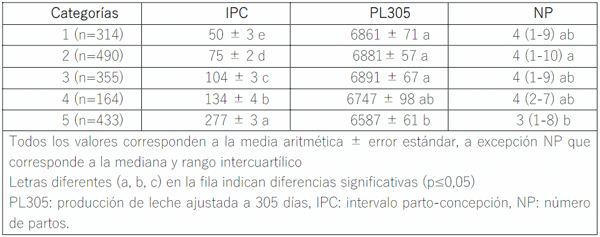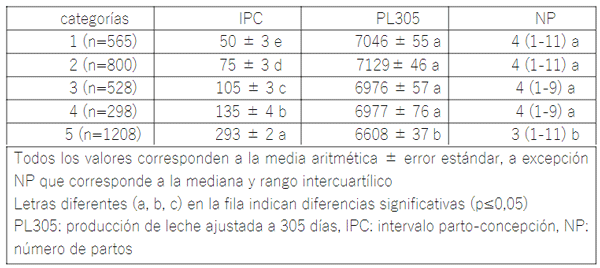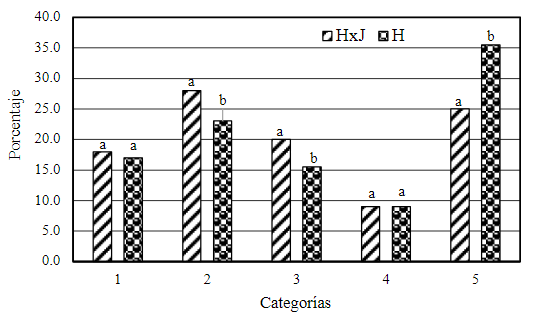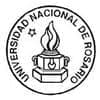Intervalo parto concepción y su impacto en la producción de primera lactancia y en la vida productiva de vacas holstein y holstein x jersey en sistemas de pastoreo
La eficiencia reproductiva esel pilareconómicoen los sistemas lecheros. El objetivo fue evaluar elefecto de los días abiertos(DA)del primer parto enla producción de lecheytiempo de vida productiva (Número de partos) de vacas Holstein (H) yHolsteinxJersey (F1 HXJ) en pastoreo en Villa Elisa, Argentina. Se analizaron5,155 lactancias (H, n=3,399 y F1 HXJ, n=1756). Las vacas se manejaron en praderas de alfalfa y fueron suplementadas con maíz en grano y silo de maíz. Seclasificaronpor DA enlas categorías: Cat1(30-60), Cat2(61-90), Cat3(91-120), Cat4(12-150) y Cat5(+151). El análisis estadístico se realizó utilizando ANOVA. Se encontró un efecto (P<0.05) categoría xraza. Las vacas F1 HXJ en cat5 tuvieron menor producción (6,587.0±61.0 L) que las vacas cat1,2,3 y 4 (6,861.0±71.0; 6,881.0±57.0; 6,891.0± 67.0; 6,747.0±.0 98 L, respectivamente).Las vacas F1 HXJcat5 tuvieron un menor NP (3) que lasF1 HXJ cat2 (4). Las vacas H cat5 tuvieron una menor producción (6,608.0±37.0 L) comparadas conlasH cat1,2,3y 4 (7,046.0± 55.0; 7,129.0±46.0; 6,976.0±57.0 y 6,977.0±76.0 L; respectivamente). Un mayor (P<0.05) porcentaje de vacas H cayeron en cat4 y 5 (44.5%) comparadas con vacas F1 HXJ (34.0%). Las vacas quetuvieron un mayor número DA en la primera lactancia tuvieron menos partos(3). En conclusión,las vacas Holstein y F1 Holstein x Jersey en Villa Elisa, Argentina con un mayor número de días abiertos en su primera lactancia tuvieron una menor producción de leche y una vida productiva más corta.
Palabras clave: fertilidad, duración de la lactancia, condición corporal, días abiertos.
INTRODUCCIÓN
MATERIALES Y MÉTODOS
RESULTADOS



DISCUSIÓN
CONCLUSIÓN
Biga, P., Barbona, I., Lammoglia-Villagómez, MA., Marini, PR. y Hernández-Carbajal, GR. 2022. Indicadores productivos y reproductivos de vacas Holstein y Holstein x Jersey durante la primera lactancia en sistemas de pastoreo. Revista Biológico Agropecuaria, Tuxpan10(2):155-170.
Cabrera, VE. 2014. Economics of fertility in high-yielding dairy cows on confined TMR systems. Animal8(1):211‒221.https://doi.org/10.1017/S1751731114000512PMID: 24679357.
Clasen, JB., Fikse, WF., Kargo, M., Rydhmer, L., Strandberg, E. y Oestergaard, S. 2020. Economic consequences of dairy crossbreeding in conventional and organic herds in Sweden. J. Dairy Sci. 103(1):514-528.
Consentini, CE., Wiltbank, MC. Y Sartori, R. 2021. Factors that optimize reproductive efficiency in dairy herds with emphasis on timed artificial inseminations programs. Animals 11(301):1-30.
CRV. 2021. International Dutch Cattle Improvement Co-operative. Jaarstatistieken 2020. https://www.cooperatie-crv.nl/downloads/cooperatie-crv/crv-jaarverslagen/. Accessed March 11, 2024. https://www.cooperatie-crv.nl/downloads/cooperatie-crv/crv-jaarverslagen/
Do, C., Wasana, N., Cho, K., Choi, Y., Choi, T.,Park, B. y Lee, D. 2013. The effect of age at first calving and calving interval on productive life and lifetime profit in Korean Holsteins. Asian Austral. J. Anim., 26, 1511‒1517. doi: 10.5713/ajas.2013.13105
Hu, H., Mu, T., Ma, Y., Wang, X., yMa, Y. 2021. Analysis of longevity traits in Holstein cattle: A review. Frontiers inGeneics 12(695543):1-15.doi: 10.3389/fgene.2021.69554.
Kim, IH.yJeong, JK. 2019. Risk factors limiting first service conception rate in dairy cows and their economic impact. Asian-Australasian J. Anim. Sci. 32(4):519‒526.https://doi.org/10.5713/ajas.18.0296PMID: 30208696.
Kok, A., Lehmann, J., Kemp, B., Hogeveen, H., van Middelaar, C., de Boer, I., yvan Knegsel, A. 2019. Production, partial cash flows and greenhouse gas emissions of simulated dairy herds with extended lactations. Animal 13:1074‒1083. . https://doi.org/10.1017/S1751731118002562.
Lammoglia, MA., Ávila, J., Alarcón, MA., Cabrera, A., Gutiérrez, A. y Daniel, I. 2013. Rendimientos productivos y reproductivos de vacas lecheras en el primer cruzamiento rotativo en el altiplano del centro de México. Veterinaria, Méx. 44(1):17-22.
Leane, S. 2016. Nutritional effects on reproduction in pasture-based milk production systems. PhD thesis. School of Agriculture and Food, National University of Ireland, University College Dublin.
Lucy, MC. 2019. Symposium review: Selection for fertility in the modern dairy cow̶Current status and future direction for genetic selection. J. Dairy Sci. 102:3706‒3721.https://doi.org/10.3168/jds.2018-15544[PubMed] [CrossRef] [Google Scholar]
Niozas, G., Tsousis, G., Steinhöfel, I., Brozos, C., Römer, A., Wiedemann, S., Bollwein, H., yKaske, M. 2019. Extended lactation in high-yielding dairy cows. I. Effects on reproductive measurements. J. Dairy Sci. 102:799‒810.https://doi.org/10.3168/jds.2018-15115
Peñagaricano, F. 2020.Genetics and genomics of dairy cattle. In Fuller W. Bazer, G. Cliff Lamb, yGuoyao Wu (Eds.), Animal Agriculture Sustainability, Challenges and Innovations (pp. 101-119). Elsevier Inc.
Ribeiro, ES., Monteiro, APA., Lima, FS., Ayres, H., Bisinotto, RS., Favoreto, M., Greco, LF., Marsola, RS., Thatcher, WW. y Santos, JEP. 2012. Effects of presynchronization and length of proestrus on fertility of grazing dairy cows subjected to a 5-day timed artificial insemination protocol. J. Dairy Sci. 95:2513-2522.
Sehested, J., Gaillard, C., Lehmann, J. O., Maciel, GM., Vestergaard, M., Weisbjerg, MR., Mogensen, L., Larsen, L. B., Poulsen, NA., yKristensen, T. 2019. Review: Extended lactation in dairy cattle. Animal, 13:s65‒s74.doi: 10.1017/S1751731119000806. [PubMed] [CrossRef] [Google Scholar]
Shahbandeh, M. 2024. Milk produced per cow 1999 ‒2024. Statistica. https://www.statista. com/statistics/194935/quantity-of-milk-produced-per-cow-in-the-us-since-1999/
Sokal, R. y Rohlf. 1969. Biometry: The principles and practice of statistics in biological research. Freeman: San Francisco. 776 pp.
Stangaferro, ML., Wijma, R., Masello, M., Thomas, M. J., yGiordano, JO. 2018. Extending the duration of the voluntary waiting period from 60 to 88 days in cows that received timed artificial insemination after the Double-Ovsynch protocol affected the reproductive performance, herd exit dynamics, and lactation performance of dairy cows. J. Dairy Sci.101(1):717-735.
van Knegsel, ATM., Burgers, EEA., Ma, J., Goselink, RMA. yKok, A. 2022. Extending lactation length: Consequences for cow, calf, and farmer. J. Anim. Sci., 100(10):skac220. doi: 10.1093/jas/skac220. PMID: 35723261; PMCID: PMC9541286.
Yusuf, M., Nakao, T., Yoshida, C., Long, ST., Gautam, G., Bimalka Kumari Ranasinghe, RMS.2011. Days in milk at first AI in dairy cows; its effect on subsequent reproductive performance and some factors influencing it. J Reprod Dev. 57(5):643‒649.https://doi.org/10.1262/jrd.10-097tPMID: 21768748.



Yo creo que el "rasgo fenotípico" conocido como longevidad o permanencia económica en el rebano a que ustedes refieren en su artículo es influenciado por otros factores enviro mentales más poderosos que el de "días entre partos".
Se ha demostrado, por ejemplo, en la Universidad de Florida que el "estrés calórico" en vacas secas durante el último tercio de la gestación, causa tremendos cambios celulares en la placentación y en el feto.
Estos cambios serian de orden "epigenético" y afectarían al animal por el resto de su vida productiva, entre ellos "permanencia en el rebano".











